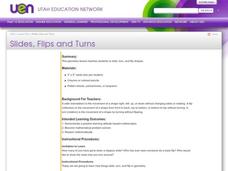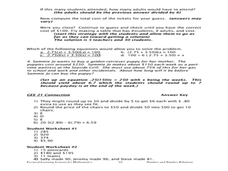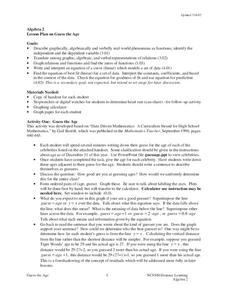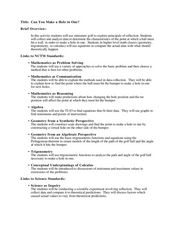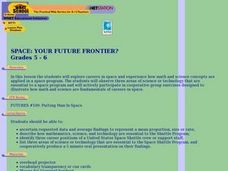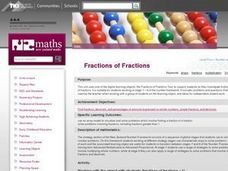Curated OER
Slides, Flips and Turns
Third graders are introduced to the meanings of the concepts slides, turns, and flips in how they relate to Geometry. As a class, they use their bodies to demonstrate how each term should look like. To end the lesson, they apply the...
Curated OER
Volume of a Stair-Step
Sixth graders calculate the volume of a stair-step. In this volume lesson, 6th graders apply their knowledge of the formula for finding volume. They practice their use of math language since this lesson is presented in a Japanese...
Curated OER
Operations for Problem-Solving
Students examine a problem and develop the best method to arrive at the solution. In this math lesson plan, students apply basic math skills by coming up with the correct steps to solve a word problem. Students estimate solutions as...
Curated OER
Guess the Age
Young scholars explore functions using real world application. In this algebra lesson, students play a game as they apply concepts of function. They graph their findings and discuss it with the class.
Curated OER
Can You Make a Hole in One?
Students relate miniature golf to reflection of an image. In this algebra lesson, students collect and graph data as they study linear equations. They apply properties of graphing to solve real life scenarios.
Curated OER
An Introduction to Functions
Learners investigate the growth and decay of an exponential function. In this algebra instructional activity, students apply properties of exponent solve problems. They identify any patterns they see in the graphs.
Curated OER
Newton's Laws of Motion
Learners investigate the effect of thin films to surface friction. In this physics lesson, students calculate the coefficient of friction using mathematical formulas. They discuss its importance in their everyday lives.
Curated OER
Planet Invasion
Students apply what they have learned about chasing/fleeing/ dodging in a game situation.
Curated OER
Basic Algebra - Lesson 4 Order of Operations
Ninth graders study the correct way to solve equations using the order of operations. They apply a mnemonic device to remember the proper order.
Curated OER
Probability: The Study of Chance
Students practice the basic principles of probability by conducting an experiment, determining if a game is fair, collecting data, interpreting data, displaying data, conducting analysis, and stating and applying the rule for probability.
Curated OER
Space: Your Future Frontier?
Students explore careers in space and experience how math and science concepts are applied in the space program through an interactive video and cooperative group activities.
Curated OER
Trigonometry in Action
Learners examine how to apply the principles of trigonometry in authentic measurement situations. They work in groups to determine the height of an object such as a flag pole by determine the angle from their position to the top.
Curated OER
Investigating Scale Factors with the Geometer's Sketchpad
Pupils use Geometer's Sketchpad to examine the scale factor when in is applied to the length of a figure's sides. They look at how the scale factor affects the side lengths, perimeter, and area of the figure that result. They work with...
Curated OER
TE Activity: Testing Fundamental Loads
Middle schoolers experiment with the five fundamental load types that can act on structures. They use foam insulation blocks to which they apply the forces and draw the fracture patterns. They determine the telltale marks of failure that...
Curated OER
Fractions of Fractions
Fourth graders use an online tool entitled the "Fraction of Fractions" tool to examine how to find a fraction of a fraction. They apply the array tool to problem solving situations. They complete paper folding activities in which they...
Curated OER
Fertilizers, Pesticides and Health
High schoolers apply real data to create and calculate algebraic equations. Students create a visual to represent the concentration for one part per million and apply unit analysis to verify measurement computations. High schoolers...
Curated OER
Math in Society
Twelfth graders determine probabilities of real-life events such as life expectancies, winning a lottery ticket and the break-even premium. They apply how life-expectation tables are used to estimate the probability that an individual...
Curated OER
KEEP ON TRUCKING
Students comprehend and apply concepts of data analysis and distributions by observing modes of transportation for food and fiber products. They are given an activity sheet "On the Lookout for Agriculture." Students discuss the discuss...
Curated OER
Travel Mug Design
Learners create and develop a travel mug. They create visuals and a three dimensional infomercial. They apply an engineering design and demonstrate knowledge of thermodynamics involved in heat transfer. They illustrate Newton's Law of...
Curated OER
Fly, Fly Away
Students use materials from their own environment to design a kite. In this kite design lesson, students research the history of kites and obtain a formal mathematical definition of a kite. Students sketch kite designs after discovering...
Curated OER
Gravity Lesson
Fifth graders study the effects of mass on gravity. In this gravity lesson, 5th graders make model parachutes and helicopters in order to apply the scientific process and find out the effects of mass on drops of the 2 objects.
Curated OER
Sampling Techniques
Sixth graders examine how to select samples and apply them to an experiment. In this sampling lesson, 6th graders use a bag of yellow and blue cubes to take a sample. They predict how many of each color there are the bag. They set up and...
Curated OER
Combination and Permutations
Students decide when to use computation and permutation to solve problems. In this algebra lesson, students apply the correct method to solve complex set of events. They differentiate between dependent and independent events.
Curated OER
Deductiva Deductions (Deductive Reasoning)
Third graders apply deductive reasoning and make predictions. For this language arts lesson, 3rd graders discuss questions and use deductive reasoning to make a prediction. Students look for patterns and prior knowledge to make predictions.


